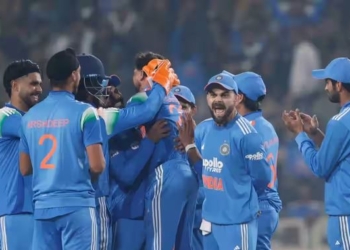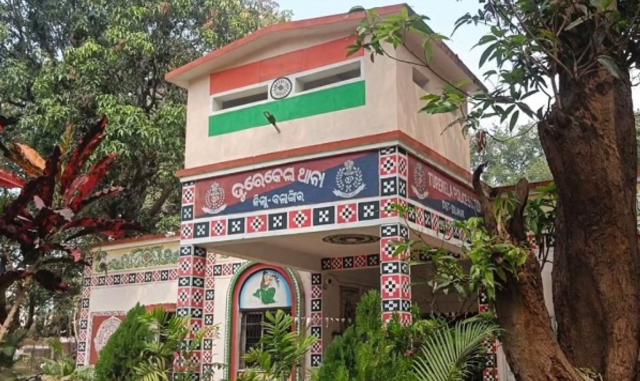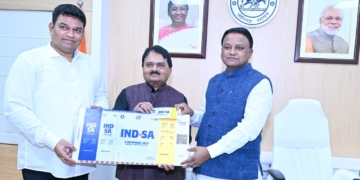Unveiling the Historical and Spiritual Grandeur of the Golden Attire Festival
On the auspicious occasion of Ashadha Shukla Ekadashi, Lord Jagannath, along with Lord Balabhadra and Devi Subhadra, adorned in the magnificent Suna Besha (golden attire), offered darshan to devotees atop their three chariots stationed at the Singhadwar in Puri.
Known as the “Bada Tadhau Besha,” this grand golden attire reflects the divine royalty of Mahaprabhu Jagannath, the King of Kings, captivating devotees with its regal splendour.
The holy town of Puri buzzed with devotion as thousands gathered to witness the deities resplendent in gold ornaments. Over 15 lakh devotees thronged the Bada Danda to behold this divine spectacle, their hearts filled with spiritual fervour.
According to the Shree Jagannath Temple Administration, the day’s rituals commenced with Mangala Alati from 7:15 AM to 7:35 AM, followed by Tadap Lagi from 7:30 AM to 7:50 AM, Abakash from 8:30 AM to 8:45 AM, and the Suna Besha preparations concluding by 9:25 AM.
Further rituals included Gopal Ballabh from 10:20 AM to 10:30 AM, Sakala Dhupa from 10:55 AM to 12:00 PM, Mailam from 12:10 PM to 12:40 PM, and Sarbanga from 1:20 PM to 1:30 PM. The evening rituals, including Sandhya Alati and Ekadashi Sarbanga, took place from 4:10 PM to 4:40 PM, with the Suna Besha darshan beginning at 4:44 PM.
The Suna Besha, one of the most significant events of the Rath Yatra, is a rare and mesmerising sight, as the deities are adorned with gold ornaments only five times a year. While four of these occasions—Magha Purnima, Kartika Purnima, Pausha Purnima, and Dussehra—take place on the Ratna Simhasana inside the Shree Jagannath Temple, the Suna Besha during Rath Yatra is unique as it occurs atop the chariots, allowing devotees from all walks of life to witness this divine grandeur.
Unlike the temple rituals, which are restricted to certain devotees, the chariot-based Suna Besha ensures that everyone can partake in this sacred experience, making it the grandest of all. The divine sight of the Chaturdha Murti (the four deities) in their golden attire left devotees in awe, marking yet another unforgettable moment in the spiritual legacy of Shree Kshetra.
The Majestic Suna Besha of Lord Jagannath: A Glittering Tradition of Puri
The Suna Besha, or the Golden Attire, of Lord Jagannath, Lord Balabhadra, and Devi Subhadra, is one of the most awe-inspiring spectacles in the spiritual landscape of Puri’s Shri Jagannath Temple.
Held annually on the sacred occasion of Bahuda Ekadashi during the Rath Yatra, this divine event transforms the Bada Danda (Grand Road) into a sea of devotees, all eager to witness the deities adorned in resplendent gold ornaments. This year, on July 6, 2025, the Suna Besha captivated lakhs of devotees, blending history, tradition, and unparalleled devotion.
A Historical Glimpse of Sunabesha
Historical records of Shri Jagannath Temple reveal that the tradition of Sunabesha began with King Indradyumna, who is believed to have first adorned Lord Jagannath in golden attire on the inaugural day of the Rath Yatra. The tradition gained prominence during the reign of Gajapati Kapilendra Deb in 1460 CE. After conquering southern India, Kapilendra Deb returned with 16 elephants laden with precious gems and gold ornaments, which he dedicated to Lord Jagannath.
On the advice of the temple’s Tadhaukarana (royal priest), the king introduced the Suna Besha on Bahuda Ekadashi, ensuring the deities’ divine splendour was accessible to all devotees. Initially, the Suna Besha was performed on the Ratna Simhasana (Gem Throne) inside the temple, restricting access to a select few. To make this divine spectacle inclusive, the Tadhaukarana urged the king to hold the ceremony atop the chariots during Bahuda Ekadashi. Since then, this tradition, also known as Bada Tadhau Besha (Grand Adornment), has been celebrated on the chariots, allowing millions to witness the divine grandeur. The name “Bada Tadhau Besha” honours the Tadhaukarana’s pivotal role in making this event accessible to all.
A Divine Spectacle on Badadanda
On July 6, 2025, Puri’s Badadanda overflowed with devotion as lakhs of devotees gathered to witness the Sunabesha. The district administration ensured meticulous arrangements to facilitate a seamless darshan experience. Sevayats (temple priests) carried the sacred gold ornaments from the Ratna Bhandar (treasury) to the chariots—Nandighosa for Lord Jagannath, Taladhwaja for Lord Balabhadra, and Darpadalana for Devi Subhadra. The deities were then adorned in their divine attire, mesmerizing devotees with their radiant beauty.
The Suna Besha, unparalleled in its magnificence, is a sight unique to Puri, with no equivalent anywhere in the world.
Traditional Ornaments of the Deities
The Sunabesha follows a meticulous tradition where specific ornaments are used to adorn each deity. According to temple customs:
- Lord Balabhadra is adorned with Shri Payar (golden feet), Shri Bhuja (golden arms), Kirita (crown), Odiani, Kundala (earrings), Chandra Surya (sun-moon motifs), Adakani, Ghagada Mali, Kadamba Mali, Tilak, Chandrika, Alaka, Jhoba KanබිKanthi, Hala and Mushala (weapons), Bahada Mali, Baghanakhi Mali, Sevati Mali, Trikhandika, and Kamarapati.
- Devi Subhadra wears Kirita, Odiani, Kana (earrings), Chandra Surya, Ghagada Mali, Kadamba Mali, Tagadi (weapons), and Sevati Mali.
- Lord Jagannath is adorned with Kirita, Shri Bhuja, Shri Payar, Odiani, Chandra Surya, Kana, Adakani, Ghagada Mali, Kadamba Mali, Tilak, Chandrika, Alaka, Jhoba Kanthi, Swarna Chakra and Raupya Shankha (weapons), Harida Kadamba Mali, Bahada Mali, Tabija Mali, Sevati Mali, and Trikhandika.
These ornaments, crafted from gold and studded with precious gems, are brought from the Ratna Bhandar and meticulously arranged by designated sevayats—Bhitirachha Mahapatra for Lord Jagannath, Talichha Mahapatra for Lord Balabhadra, and Pushpalaka for Devi Subhadra.
The Suna Besha occurs five times a year—Pousha Purnima, Phalguna Purnima, Bahuda Ekadashi, Kartika Purnima, and Vijayadashami—each event showcasing the divine opulence of the deities.
Spiritual and Cultural Significance
Among the various beshas (attires) of Lord Jagannath, the Suna Besha stands out for its display of divine opulence and sweetness. While other beshas highlight the deities’ grace and charm, the Suna Besha radiates regal splendour. Historical inscriptions reveal that Odisha’s rulers, including Ananga Bhima Deva III (1211–1238 CE), Langula Narasingha Deva (1238–1264), Bhanudeva III (1308–1328), and Kapilendra Deb (1435–1466), revered Lord Jagannath as the true king of Odisha, considering themselves His humble servants. Kapilendra Deb, in particular, popularized the deity as the national deity, dedicating vast treasures to the temple.
The Bada Tadhau Besha, as it is also called, symbolizes this royal devotion. The gold ornaments, including 138 types of jewellery such as Ratna Kirita, Kana Phula, Markata Mukuta, and Kanti Jaraka, were offered by Kapilendra Deb in 1460, as recorded in the Jayavijaya Dwar inscription. The decision to hold the Sunabesha on the chariots was a landmark move to ensure that devotees from all walks of life could partake in this divine experience.
A Timeless Tradition
The Sunabesha remains a testament to Odisha’s rich cultural and spiritual heritage. The sight of Lord Jagannath, Lord Balabhadra, and Devi Subhadra in their golden splendour atop the chariots evokes profound devotion and awe.







































